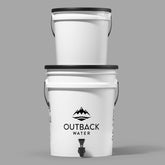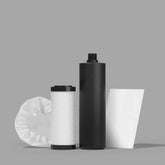If you have other questions, please email us at info@outbackwater.com.
- All
- How Does The Outback Ready System Work?
- Filtration Versus Purification - What Does The Outback Remove?
- History, Effectiveness and Reliability - Proven Through Long-Term Use And Testing
- Questions About The Outback Ready System And Their Use
How Does The Outback Ready System Work?
The Outback Ready system can produce enough drinking water for up to four people at one gallon per day for up to one year.
Up to 24 gallons of purified water every day and up to 1,800 gallons over the life of each filter system.
It comes with a Net Filter to remove large particles, a Sleeve Filter to remove microparticles, a Purifying Filter to eliminate bacteria, cysts, and viruses, and a Refining Filter to remove chemicals and contaminants.
Yes. Extra filters are available for sale at outbackwater.com or in our Amazon store.
Absolutely. Assembling The Outback Ready system takes less than five minutes.
It’s always best to use clear water from a fresh source like streams, creeks, rivers, ponds and lakes. But you can also use water from swimming pools, rainwater collection, water heaters, spas, and untreated stored water.
Yes, just grab the handle and go. Portability was an important factor when designing the system, in the event someone was forced to leave their home.
Effectiveness, simplicity and true portability make The Outback Ready a superior water filtration system. This is a rugged and reliable system that can save lives during an emergency and protect people who live in underdeveloped areas. All without chemicals or the need for power.
Yes. The high-capacity, Refining Filter removes any “off” taste or smell before the water enters the lower, purified water container leaving nothing but clean, good-tasting water.
Using nothing but gravity and our patented, four-stage filter system, The Outback Ready system provides purified water that meets EPA standards*.
Our patented system provides four separate but equally-important stages of filtration:
Stage 1 – The Pre-Filter Net. This pre-filter fits over the mouth of the source-water pail. It removes large particles and debris.
Stage 2 – The Filter Sleeve. In the source-water pail, this pre-filter fits over the fibrous purification filter and removes finer particles like sand and sediment.
Stage 3 – The Fibrous Purification Filter. Inside the purified water pail, this filter removes water-borne microorganisms such as bacteria, cysts and viruses.
Stage 4 – The Multimedia Cartridge. Installed in the purified water pail to remove a multitude of chemicals, pesticides, organic contaminants as well as any “off” flavor or smell.
A. The easiest way to know when to replace your filters is when you notice a reduction in flow from the system. But based on years of field trials:
– The Pre-Filter Net and Filter Sleeve can be washed and reused, and should need replacing based on what’s recommended in the user manual.
– The Fibrous Purification Filter needs to be replaced every 6 months.
– The Multimedia Cartridge should be replaced after 12 months or once it
– The Multimedia Cartridge should be replaced after 12 months or once it has reached its rated capacity (up to 1800 gallons).
Using the clearest possible water source, a settling bucket and keeping the pre-filter sleeves clean will help prolong the life of your filters.
Nanofiltration is a method of capturing microorganisms by employing a fibrous filter with an opposite electric charge to attract and absorb contaminants. Most particles are electronegative in water, which means an electropositive filter is highly effective. This fibrous media consists of small filters, two nanometers in diameter, which are dispersed throughout a cellulose, polymetric, micro glass fiber matrix which results in a 2-micron pore size filter media. A single layer of this media can capture more than 99% of viruses 0.025 micron in size. This type of filter is pleated to produce a high surface area with maximum flow rate and minimal pressure drop. They can also be used to form multilayer filters capable of capturing virus size particles at a rate greater than 99.9999%.
High density polyethylene plastic (HDPE). This is BPA free, FDA approved and food-grade plastic that’s also used in food packaging such as milk and snack packs.
The difference between the three most common pathogenic (capable of causing disease) microorganisms are:
Bacteria: Single-celled organisms that lack well-defined nuclear membranes, other specialized functional cell parts, and also reproduce by cell division or spores. These could be free living organisms or parasites that range from 1 - 10-micron in length and 0.2 - 1-micron in width.
Cyst: A capsule or protective sac produced by many protozoans, as well as some bacteria and algae, as preparation for entering a resting or specialized reproductive stage. Generally 2 - 50-micron in diameter.
Virus: A parasitic infectious microbe composed almost entirely of nucleic acid which can cause disease in humans. Viruses can only reproduce within living cells, and they are 0.004 - 0.1-micron in size, about 100 times smaller than bacteria.
A settling bucket is used to collect untreated water so sediment, dirt, and fine particles can “settle” at the bottom. One is recommended to prevent premature filter “exhaustion” when untreated water contains a large amount of fine silt, sand, etc.
Filtration Versus Purification - What Does The Outback Remove?
By EPA standards, to be considered a “water purifier” a device must remove microorganisms at a rate of: 99.9999% for bacteria, 99.9% for cysts, and 99.99% for viruses.
Yes. The Outback Ready meets the EPA’s standards for “purifier.”
Yes. The Outback Ready system effectively removes more than 99.9999% of bacteria like E. coli and Cholera from water.
Yes. Our system removes more than 99.99% of cysts like giardia and cryptosporidium, exceeding EPA standards.
Yes. Our patented, emergency water filtration technology removes more than 99.99% of viruses such as coronaviruses, hepatitis and polio from water.
Yes. The Outback Ready uses a mixed blend combination of carbon (multimedia) formulated to remove a long list of contaminants.
No. The Outback Ready is not designed to remove salt from water.
History, Effectiveness and Reliability - Proven Through Long-Term Use And Testing
For over 20 years our system has provided life-protecting water at home and around the world.
Individuals, small groups, and relief organizations like The Peace Corps use The Outback Ready system for humanitarian aid and emergency water filtration preparedness.
Yes. Multiple studies have shown that viruses (including those from human fecal matter) are common in groundwater, and a study in Minnesota showed that 24% of tap water is virus positive.
Yes. The Outback Ready has been tested multiple times by certified, third-party, independent laboratories both in the U.S. and by the first lab in South Asia recognized by the Water Quality Association
Questions About The Outback Ready System And Their Use
Yes. Discard the first few gallons of water to get rid of any carbon dust that might be present in a new filter. Please note: carbon dust is not harmful if swallowed.
Unassembled The Outback Ready measures 12” x 12” X 15”. Fully assembled it measures 12” x 12” x 24”.
Empty, the whole system weighs just 6lbs but it can weigh up to 48lbs when full of water.
Indefinitely, as long as it's left in its original packaging and not stored in direct sunlight.
No. The Outback Ready is extremely effective at turning dirty water into clean, safe drinking water without chemicals or power.
Yes. We ship to customers around the world.
Yes. The Outback Ready and its components are covered under a normal-use, one-year warranty.
Every component of The Outback Ready is made in the United States except the pre-filter net and sleeve, which are made in Ontario, Canada.
Yes. The Outback Ready system is a patented product.





